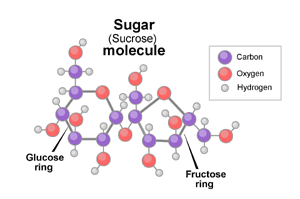Question #c2141
1 Answer
Here's what I got.
Explanation:
In order to determine how many atoms of carbon you have in your sample, you must use a series of conversion factors to take you from
grams of sucrose
#-># moles of sucrose#-># molecules of sucrose#-># atoms of carbon
To go from grams of sucrose to moles of sucrose, use the molar mass of the compound. Your sample will contain
#1.0 color(red)(cancel(color(black)("g"))) * ("1 mole C"_12"H"_22"O"_11)/(342.3color(red)(cancel(color(black)("g")))) = "0.0029214 moles C"_12"H"_22"O"_11#
Now, you can go from moles of sucrose to number of molecules of sucrose by using Avogadro's constant, which is essentially the definition of a mole.
Your sample will contain
#0.0029214 color(red)(cancel(color(black)("moles C"_12"H"_22"O"_11))) * (6.022 * 10^(22)"molecules C"_12"H"_22"O"_11)/(1color(red)(cancel(color(black)("mole C"_12"H"_22"O"_11))))#
#= 1.7593 * 10^(21)"molecules C"_12"H"_22"O"_11#
Now, as its chemical formula suggest, every molecule of sucrose contains
- twelve atoms of carbon,
#12 xx "C"# - twenty two atoms of hydrogen,
#22 xx "H"# - eleven atoms of oxygen,
#11 xx "O"#

This means that your sample will contain
#1.7593 * 10^(21) color(red)(cancel(color(black)("molecules C"_12"H"_22"O"_11))) * "12 atoms C"/(1color(red)(cancel(color(black)("molecule C"_12"H"_22"O"_11))))#
# = color(darkgreen)(ul(color(black)(2.1 * 10^(22)"atoms of C")))#
The answer is rounded to two sig figs, the number of sig figs you have for the mass of sucrose.

